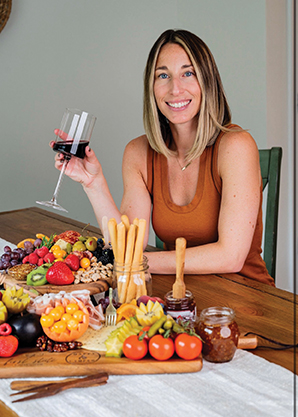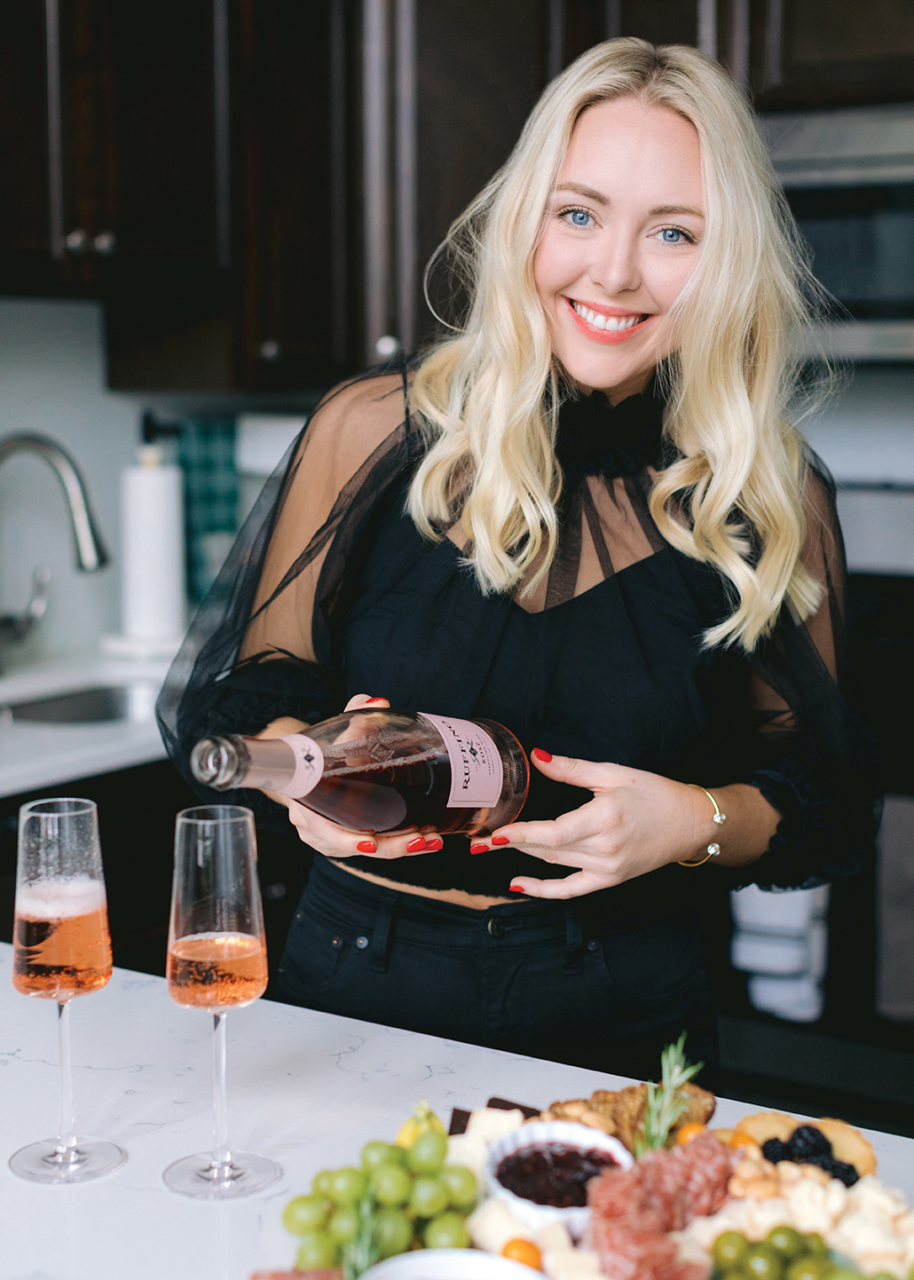The popularity of charcuterie has never been higher — so we’re serving advice from some of the industry’s best to make your boards beautiful and delicious
Written by Nicole Davis | Lead image by Olivia Carney
If you’ve been to a trendy restaurant lately — or even if you’ve done some Pinterest browsing at home — odds are, you’ve drooled over a charcuterie board. These beautiful, overflowing platters are filled with cured meats, cheeses, fruits and vegetables, crackers and plenty of delicious dips and spreads, all skillfully arranged and begging to be eaten.
These boards have skyrocketed in popularity, in part due to the very visual and community-centered nature of social media platforms, like Instagram. Charcuterie boards allow people to create a chef-level-looking plate of food without a ton of work, and the possibilities and combinations are endless.
And although modern charcuterie boards are en vogue, the history of this delicacy runs deep. Created in France in the 15th century, charcuterie literally means “flesh” and “cooked” in French, and the word actually referred to shops that sold pork products. A bit of a technicality before we dive in, too: Charcuterie includes only meat and small accoutrements, like pickled vegetables. If there’s cheese and fruit on the board, it’s better referred to as a cheeseboard.
In these pages, we tapped four women who have created businesses around boards — Maegan Brown, aka The BakerMama; Dimitria Hare-Michael; Olivia Carney, aka That Charcuterie Chick; and local Jenna Bullock, owner of First State Charcuterie — to give us their best advice for making a board at home, as well as the anatomy of an A+ charcuterie or cheeseboard. Read on and get inspired to put your own best board forward.
Jenna Bullock, First State Charcuterie


Why do you think charcuterie boards are so popular today?
For so many reasons! The visual appeal alone; it pairs so well with all wine; it’s a healthier alternative than most snacks or appetizers; it’s the perfect gift, and everyone has a favorite charcuterie item, so it’s always a crowd-pleaser!
A lot of people love the idea of charcuterie boards but are intimidated by creating one on their own. What’s the best advice you would give to a charcuterie newbie?
Have fun and create! Not everyone’s style is the same. I would suggest a newbie scatter the products of the same color or texture, so they are not right next to each other on the board. It helps give the board more of a well-rounded look.
What does your ideal charcuterie board consist of?
I like to change it up often, but my go-to products on a board are always seasoned kalamata olives, dried apricots, peppered salami, brie and goat cheese with honey and strawberries. Currently, we have some fall products, such as Pumpkin Spice Gouda and Goat Cheese, so I’m playing around with different pairings.
@first.state.charcuterie | FirstStateCharcuterie.com
Maegan Brown, aka The BakerMama


How did you get into the art of charcuterie?
When I was growing up, my mom would place all our meals and snacks on a wooden lazy Susan in the middle of our dining table. She still has it on her table today! My husband and I have adapted the same concept to our home with our kids and when we entertain. We love entertaining but don’t always want to cook a big meal. Once I started creating beautiful charcuterie and cheeseboards for appetizers and meals, it quickly became our favorite way to serve. It really is a simple and stunning way to serve food.
A lot of people love the idea of charcuterie boards but are intimidated by creating one on their own. What’s the best advice you would give to a charcuterie newbie?
Just go for it! Once you build your first board, you’ll be hooked and want to do it again and again. I highly recommend getting a copy of my Beautiful Boards book for amazing board-building inspiration and detailed instructions. Select the foods that you and your loved ones would enjoy most and start arranging them on the board.
The enjoyment that goes into arranging beautiful and delicious foods on a board and the satisfaction that goes into serving it and grazing on your creation with your loved ones is truly magical.
What does your ideal charcuterie board consist of?
I love trying different items on my charcuterie and cheeseboards each time. What’s so fun about charcuterie boards is that you can have a completely different experience each time if you want. Here are some of my go-to items though:
Cheeses: creamy brie, aged gouda, and aged white cheddar
Meats: prosciutto and calabrese salami
Fresh Fruits: Honeycrisp apple slices, grapes and fresh figs
Crackers: fruit + seed crisps and salted pita crackers
Nuts: candied pecans and Marcona almonds
Dried Fruits: dried apricots and candied pecans
Pickled Veggies: cornichons and olives
Spreads: honey and fig jam
@thebakermama | TheBakerMama.com
Dimitria Hare-Michael, Grate Boards


Why do you think charcuterie boards are so popular today?
I think this trend has exploded over the last few years for a few reasons. The power of social media is definitely the number-one reason for this trend. People saw how fun and versatile these boards could be. You can truly put anything on a board, style it the way you want, and your guests are free to graze for hours to come. I think during quarantine, people found themselves trying new things, and cheeseboards were easy.
What makes a good charcuterie board in your opinion?
A few things. The first being amazing cheeses. I typically like to include a variety of both hard and soft cheeses and a variety of different milks, such as cow’s-milk cheese, goat cheese and/or sheep’s-milk cheese. The second thing is it needs a lot of color, which typically comes from fresh fruit. And lastly, from an aesthetic perspective, you must garnish your boards. Garnishing could come from fresh herbs, like rosemary or sage, or edible flowers, such as pansies or nasturtiums. This final step really ties your board together, and it can break up any odd colors or any holes on the board.
A lot of people love the idea of charcuterie boards but are intimidated by creating one on their own. What’s the best advice you would give to a charcuterie newbie?
Start simple, grabbing a few good cheeses — at least three types. From there, cut up any cheeses you can and crumble any hard cheeses to be bite-size. Cutting up your cheeses can definitely elevate the way your board looks and will be easier for your guests to enjoy, but of course, many soft cheeses you cannot cut up, so in that case, it is fine to leave those whole. Same goes for the meats — styling the charcuterie is very important, so it doesn’t look like just a blob of meat on a platter. Even if you just simply fold some of the meat, it truly can elevate your board a lot. Don’t be afraid to use a variety of different fruits — those will add the color your board will need in order to be a showstopper. Lastly, be sure to get a bunch of small bowls or ramekins — those are great for things like jams or honeys, plus olives or cornichons and any other dips or spreadable cheeses you may have.
@grateboards | GrateBoards.com
Olivia Carney, The Charcuterie Chick


Why do you think charcuterie boards are so popular today?
Short answer: It’s a socially acceptable way for adults to play with their food! Longer answer: I think in this day and age, where pleasing aesthetics dominate social media, the idea of elevating a traditional charcuterie board was an exciting revelation. Cheeseboards and charcuterie boards are luxurious, sophisticated, and some think of it as a form of self-care. I think the pandemic actually sparked a bit of interest around the delicious platter of food; everyone was bored and wanted to treat themselves. And share it online, of course!
What makes a good charcuterie board in your opinion?
I think a “good” charcuterie board is totally subjective. Your creation should be a reflection of the flavors, textures and pairings you love. I highly recommend choosing a few cheeses that you enjoy and throwing in a new one every now and again. Same goes for charcuterie and accoutrements (cornichons, jams, nuts, etc.): Choose a few of your favorites, but try to introduce new flavors and textures when you can. A traditional charcuterie board is typically more cured meat than anything else, so be sure to include this! If you want to omit the meat, that’s totally fine, but it would then be categorized as a cheeseboard, or hot cocoa board, or breakfast board, whatever your heart desires. Let your creative juices flow!
What does your ideal charcuterie board consist of?
I follow 6 steps to building the ideal board:
Ramekins or small bowls: These will be filled with honey, jam or briny items. It’s good to place these earlier on, to save space.
Cheese: Choose 2-3 cheeses; try selecting cheese with different milks, flavors and textures. Don’t forget to try something new!
Large produce: Think grape bunches, pears, apples, etc. You want to make sure there is ample space left for these larger items, so they are plated early.
Crunch: Add crackers to the board for added texture and color variance, but it’s best to keep it minimal. I recommend having a plate or basket off to the side with more for your guests.
Meat and small produce: Next, layer your charcuterie meats and your smaller produce (berries, veggies, etc.)
Nuts and garnish: Lastly, fill any small open space with nuts and herbs for garnish!
@charcuterie.chick
Vintage 414

POPULAR CHOICE
The Vintage 414 team of Emily Salisbury, Natalie Brewer and Colleen Hughes won multiple awards in Coastal Style’s Best Of 2021 Readers’ Poll, including Best Cheeseboard and Best Wine List in Dorchester/Talbot Counties.

Photos by Jill Jasuta
Ready to try a charcuterie board at a new wine bar? Check out Vintage 414 in Cambridge. Chef Emily Salisbury, co-owner, gives you a taste of what you can expect:
“At Vintage 414, we make sure our boards are built around specific regions,” she said. “ Good charcuterie boards should be bonded together, not only by flavors, but an overall theme. Showcasing multiple textures on the board is key.”
When asked how to create a good board at home, here’s what Chef Salisbury said, “Don’t be afraid to step outside of the box and try something new. The worst charcuterie boards have the same old components your grandmother used. Now, more than ever, unique foods are widely available. In the end, it’s just meat and cheese, so have fun. People are going to eat it no matter what. Spend your time on more important things — like wine!”
Visit them at 414 Race Street in Cambridge and online at Vintage414.com. CS
